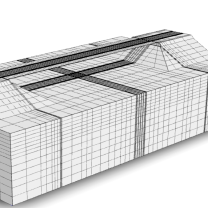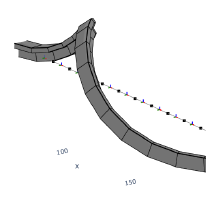Jan. 18, 2025
Consider the inertia tensor $\bm{I}_x$ defined by
$$ \bm{I}_x \triangleq \int \bm{x} \cdot \bm{x} \, \mathbb{1} - \bm{x} \otimes \bm{x} \, \mathrm{d} \alpha $$ The transformed tensor $\bm{I}_{x+\rho}$ corresponding to a translation by $\bm{\rho}$ is obtained by replacing $\bm{x}$ with $\bm{x} + \bm{\rho}$, furnishing
$$ \bm{I}_{x+\rho} = \bm{I}_x + 2 A \,\bm{\rho}\cdot \bar{\bm{\rho}} \, \mathbb{1} - A (\bar{\bm{\rho}}\otimes\bm{\rho} + \bm{\rho}\otimes\bar{\bm{\rho}}) + A (\bm{\rho}\cdot\bm{\rho}\,\mathbb{1} - \bm{\rho}\otimes\bm{\rho}) $$ where the centroid $\bar{\bm{\rho}}$ and area $A$ are defined as
Jan. 1, 0001
One says that balance of energy holds if, for every nice open set $\mathcal{U} \subset \mathcal{B}$, $$ \frac{d}{\mathrm{~d} t} \int_{\varphi_t(\mathcal{U})} \rho\left(e+\frac{1}{2}\langle\langle\mathbf{v}, \mathbf{v}\rangle\rangle\right) \mathrm{d} v=\int_{\varphi_t(\mathcal{U})} \rho(\langle\langle\mathbf{b}, \mathbf{v}\rangle\rangle+r) \mathrm{d} v+\int_{\partial \varphi_l(\mathcal{U})}(\langle\langle\mathbf{t}, \mathbf{v}\rangle\rangle+h) \mathrm{d} a, $$ where $e=e(\mathbf{x}, t), r=r(\mathbf{x}, t)$ and $h=h(\mathbf{x}, \hat{\mathbf{n}}, t)$ are internal energy per unit mass, heat supply per unit mass and heat flux, respectively.
Balance of energy. For an elastic material one assumes that there exists a strain energy function $e$ per unit mass whose change represents the change in the internal energy due to mechanical deformations.
Jan. 1, 0001
This note develops some of the theory supporting the ShearFiber finite element section model in OpenSees. We look to motivate the definition of the monosymmetry constant $\beta_z$.
When higher order kinematic terms are incorporated in the formulation of a cross section, an additional term \(T_{\mathrm{wag}}\) contributes to the resultant torque \(T\):
$$ T_{\mathrm{wag}} \triangleq \vartheta' \int \sigma \tilde{r}^2\, \mathrm{d}\alpha $$ where $\tilde{r}^2 \triangleq (y-\tilde{\rho}_y)^2 + (z-\tilde{\rho}_z)^2$ and
$$ \sigma = E\, \begin{bmatrix} 1 & z & -y & -\varphi \end{bmatrix} \begin{pmatrix} \varepsilon \\ \theta_y' \\ \theta_z' \\ \vartheta'' \end{pmatrix} $$ so that


